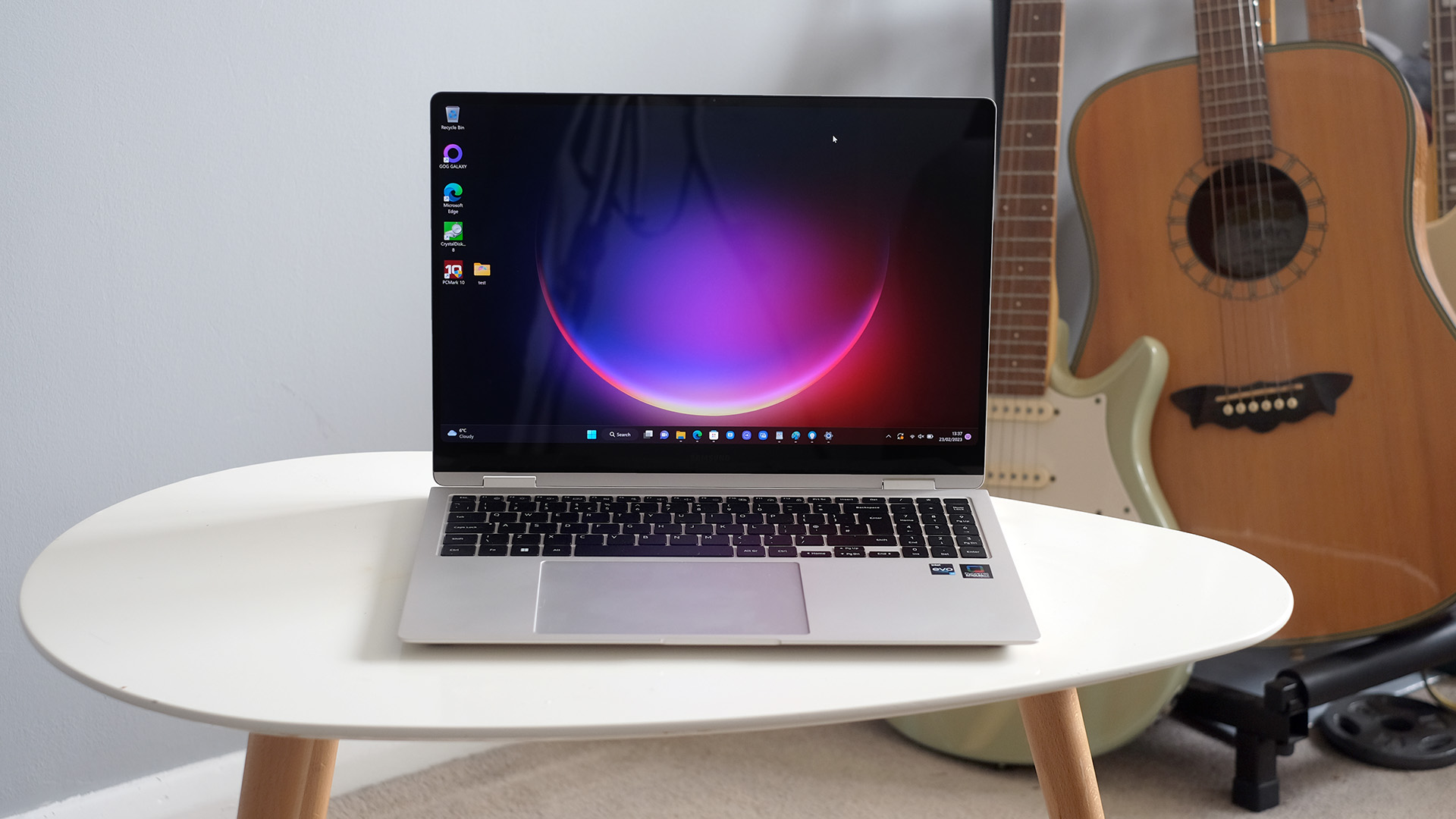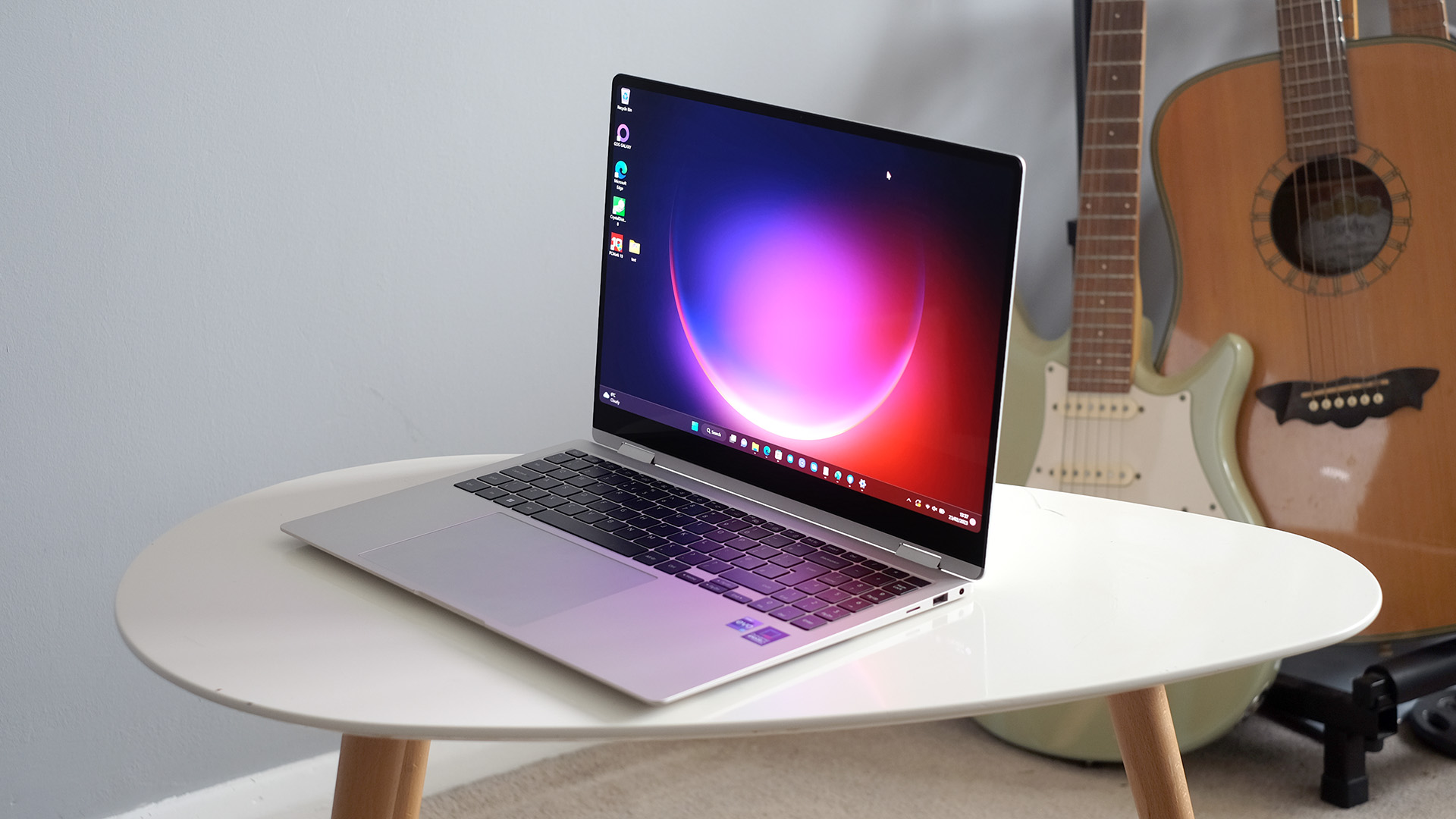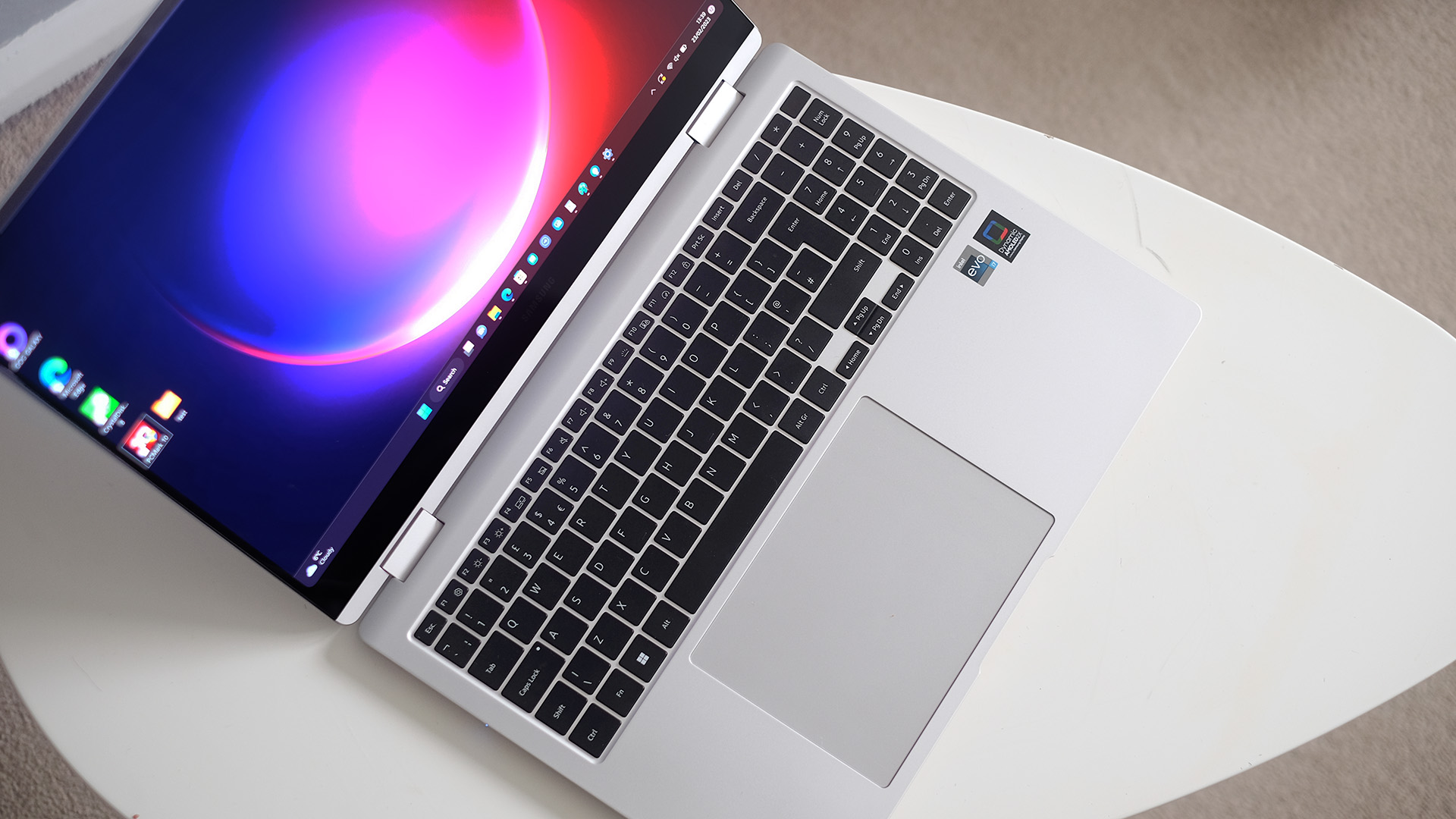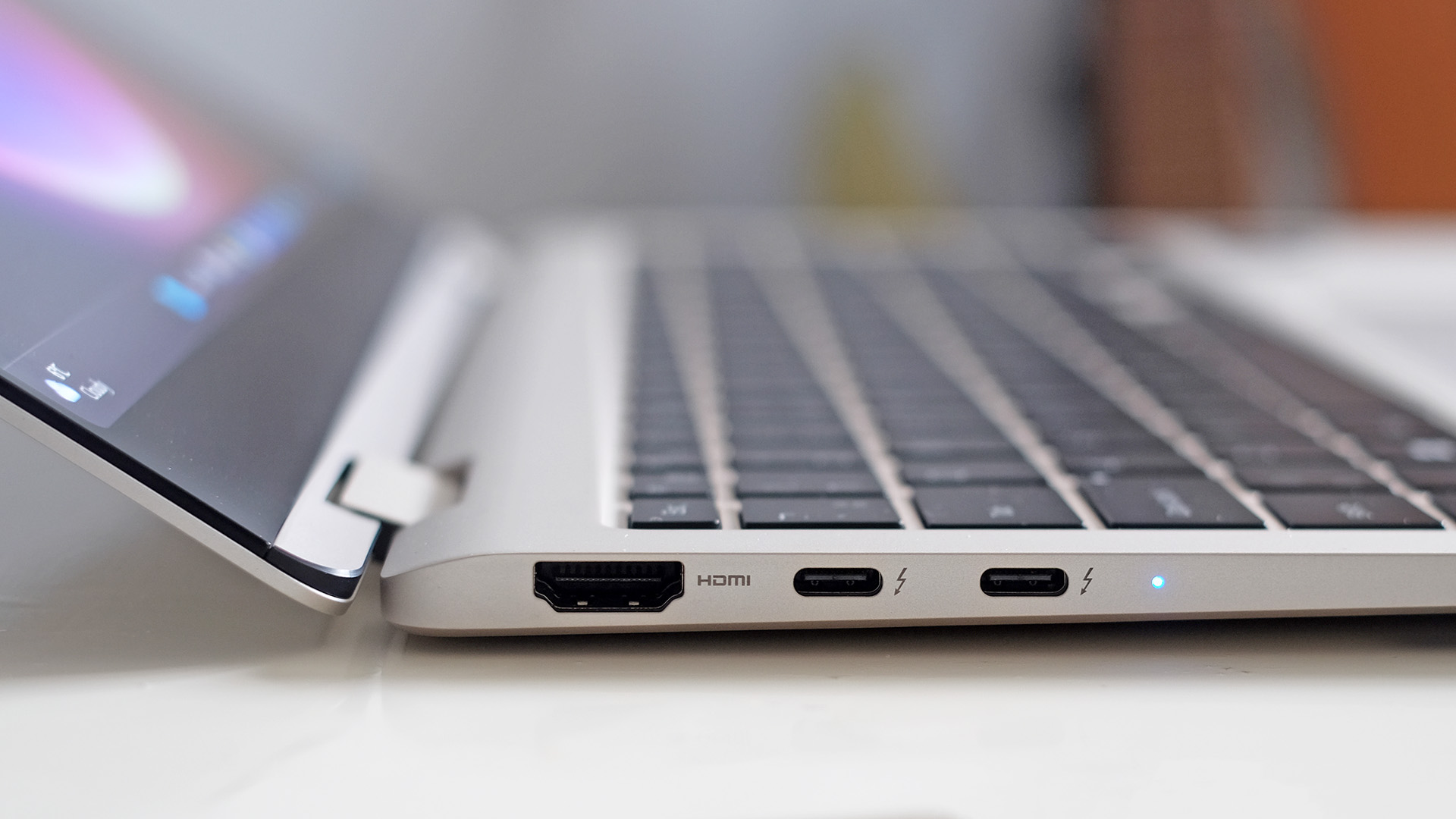Samsung Galaxy Book 3 Pro 360 review: a flippy and flashy ultra-portable
The 360-degree hinge makes the Samsung Galaxy Book 3 Pro 360 mighty versatile, but it's also mighty expensive - so is it worth it?


It may cost a bunch but the Samsung Galaxy Book 3 Pro 360 has the design and display tech to (mostly) justify it. This is about as flashy as ultraportable Windows laptops get.
-
+
Rich OLED screen
-
+
Great build quality
-
+
More physically versatile than a MacBook
-
+
Absolutely gigantic touchpad
-
-
Wobble-prone screen
-
-
Expensive
-
-
Slight performance throttling
Why you can trust T3

Your first assumption when you see the Samsung Galaxy Book 3 Pro 360 is probably: "Is Samsung 'doing a MacBook Pro' here?". It kinda is, but the approach varies in a whole stack of ways in its attempt to make one of the best 2-in-1 laptops.
You get a Samsung signature OLED screen instead of an LCD one. It's a touchscreen, one that folds back by 360 degrees. The Samsung is significantly lighter than a 16-inch MacBook Pro, too, plus it supports a stylus that's bundled in. This thing can do stuff a MacBook can't.
But is it a true killer for design pros? A few little wobbles hold this Samsung back from being the best laptop ever, but not enough to spot this being a world-class laptop for those who want large-screen portability.
Samsung Galaxy Book 3 Pro 360: Price & Availability

The Samsung Galaxy Book 3 Pro 360 released in early 2023 as one of Samsung's most expensive laptops. Our review version is worth £1849 and features 16GB RAM and 512GB SSD.
Samsung also makes a version with 5G mobile internet for £1999. Or there's a cheaper model with an Intel Core i5, 8GB RAM and a 256GB SSD for £1549. But I think an extra £300 for a better CPU, an additional 8GB RAM and 256GB storage is a much better deal.
Samsung Galaxy Book 3 Pro 360 review: Design

The Samsung Galaxy Book 3 Pro 360 is a big laptop, but not a heavy or thick one, and every part of it feels great. Its lid, keyboard plate and bottom panel are all aluminium, while the screen surface is glass.
It weighs 1.8kg, which while fairly light for a laptop with a 16-inch screen, it's not nearly as light as an Acer Swift Edge or LG Gram 16. So not quite top of the best lightweight laptops list either. But you know what? I don't mind. Ultra-light large-screen laptops often have a slightly hollow feel to them, and body panels tend to bend a bit. The Samsung Galaxy Book 3 Pro 360 is an altogether stiffer thing. It looks and feels the business.
Get all the latest news, reviews, deals and buying guides on gorgeous tech, home and active products from the T3 experts
There's one part I'm not 100% down with, though, and it's something I've seen in multiple earlier Samsung laptops: the hinge is a little too wobble-prone. A slight tap will send it fractionally boinging back and forward, an effect emphasised by the reflectivity of the glossy glass screen.
It's what you get when you make a 360-degree hinge laptop, but you also want the luxurious effect of being able to open it (from a fully closed state) with one finger. It's the laptop feature equivalent of a flashy start-up buying Herman Miller office chairs for their entire staff. But I'd rather have a more solid hinge when not working on anything less than a solid wood desk.
That niggle aside, the Samsung Galaxy Book 3 Pro 360 can perform all the usual 360-degree hybrid tricks. You can set it up in the "tent" position, which angles the screen forward a bit while shrinking the laptop's footprint. Or you can fold the screen all the way back, for use as a digital notepad.
That arrangement can often seem a bit pointless, but it makes more sense here as the Samsung Galaxy Book 3 Pro 360 includes a pressure-sensing S-Pen stylus. This is not a super-tech-packed Bluetooth wireless pen. However, all of that stuff is really window dressing to the actual important stuff, which the S Pen does have - 4096 pressure sensitivity levels and near-lag-free operation. It also has a lovely slightly soft nib, for a smoother feel.
Samsung Galaxy Book 3 Pro 360 review: Display

A sticker on the Samsung Galaxy Book 3 Pro 360 tells you exactly the kind of screen this laptop uses. It's a Dynamic AMOLED 2X by Samsung Display. You can read all sorts of marketing guff about what this means, but the only bit with any real substance is that the maximum refresh rate is 120Hz rather than the usual 60Hz. Samsung uses its Dynamic mode as standard, which switches refresh rate based on the context.
All other aspects of the screen are just what you'd expect from an OLED display. Colour depth is fantastic, and contrast is perfect - at least in a dark room. There does seem to be a hint of internal reflectivity to the screen architecture that makes black appear just fractionally off pure black in a well-lit room, but it's still lightyears ahead of some of the budget OLED laptop screens we've seen.
And brightness? While the Samsung Galaxy Book 3 Pro 360 gives off a fantastic impression of brightness thanks to its ultra-high contrast, we only measured peak brightness at around 400 nits. That's solid, but the top MacBook Pros can reach 1000 nits, or a dazzling 1600 nits when showing HDR content. 400 nits is the minimum we’d expect for a laptop this pricey.
Still, the Samsung Galaxy Book Pro 360 3 has a super-satisfying screen. It's also one of the classiest-looking laptops we've reviewed as there are modes to let you tone down the colour - full-bore OLED colour can look pretty intense.
Samsung Galaxy Book 3 Pro 360 review: Keyboard & Trackpad

Samsung keyboards have been a mixed bag over the just three years since Samsung laptops returned to the UK market, often a bit too shallow and insubstantial. The Samsung Galaxy Book 3 Pro 360's keyboard is still shallow, but it packs bags of positive feedback into what looks around a 1mm or so depress action.
As such, this is a fairly Apple-like keyboard, but one with a (possibly) handy NUM Pad stacked along its right. I am a big fan of more meaty keys, like those of the Lenovo Thinkpad X1 Carbon series. But I have to admit I have quite enjoyed typing on this one.
The feedback style leads to a certain higher-pitch clickiness here, but there's solid resistance to provide substance you might not expect from such slimline keys. There's also a fingerprint scanner built into the icon-less power button at the top-right. Nice 'n' low-key.
And what can we say about the touchpad other than that it's absolutely massive? Quite a lot actually.
The sheer size of the thing makes the touchpad a Samsung Galaxy Book 3 Pro 360 focal point, but its style is quite traditional. It uses a mechanical clicker, not the increasingly trendy haptic kind.
This is a good thing in my opinion. While it leaves the Samsung Galaxy Book 3 Pro 360 pad with a whacking great big inch-thick dead zone at the top, which basically can't be clicked, it means the clicker feel gets to be way more substantial than pretty much any haptic model. Yes, including the MacBook Pro's one.
This Samsung touchpad doesn't quite have the velvety smooth clicker of the best mechanical Microsoft Surface models. It is perhaps a touch bright. But getting this big of a work surface without compromising the keyboard? That is quite something. And the surface is textured glass, as you'd hope given how much this thing costs.
I’d recommend tweaking the “right click” behaviour here, as the off-centre positioning leads to lots of accidental right button presses. You can thank the NUM Pad for that.
Samsung Galaxy Book 3 Pro 360 review: Performance

The Samsung Galaxy Book 3 Pro 360 is a mid-performance laptop. It uses 13th Gen Intel processors, and Samsung picked the top-end Core i7 from the mid-tier P-series for this one, an Intel Core i7-1360P. You also get 16GB RAM and an ultra-fast 512GB SSD that can read data at around 6700MB/s.
This leads to the kind of headache-free performance you'd hope for after spending this much cash.
However, the Samsung Galaxy Book Pro 360 3 is an everyday performance laptop, not a true powerhouse. It relies on the baked in Intel Xe graphics, which haven't really improved much in the last couple of years. A laptop with an AMD Ryzen 6800U could whoop the Samsung Galaxy Book 3 Pro 360 for gaming.
Still, you can play last-gen console games. And you can video edit and photo edit on this thing, no problem. The glorious OLED screen will help there too.
You do have to pay attention to the performance mode you are in, though. A keyboard shortcut swaps you between Silent, Quiet, Optimised and High Performance modes.
Silent is kinda awesome for disruption-free work, but you'll only get the top-tier performance of the Samsung Galaxy Book 3 Pro 360 in, you guessed it, High Performance.
And in this top-end mode the laptop doesn’t reach the kind of peak performance you might see in a chunkier laptop with this CPU. In Geekbench 5 it scores 9455 points, where laptops with the same processor can score 1000 points more, around 10% extra.
This will be because Samsung keeps a lid on the turbo mode, to lower heat generation. And I'm hardly mad about this.
The Samsung Galaxy Book 3 Pro 360 fan tone is not too distracting even when working flat-out, because there are no distracting ramp-ups and downs, and the volume is never loud. Use the lower performance modes and it will often be completely silent - and it's smart enough not to create noise when you write a shopping list in High Performance, obviously.
Samsung Galaxy Book 3 Pro 360 review: Battery life

You want a laptop like the Samsung Galaxy Book 3 Pro 360 to last through a full day of work. The MacBook Pro 16 with M2 processors can do it, as can the LG Gram 16 and Huawei Matebook 16. Easily.
The Samsung Galaxy Book Pro 360 3 doesn't hold up quite as well though. I found it will last a little under eight hours when used to write documents and browse the web.
However, when purely streaming video it lasts a little over nine-and-a-half hours - better, if not nearly class-leading. It's not going to beat a MacBook Pro 16 or LG Gram 16.
The Samsung Galaxy Book Pro 360 3 does have MacBook-beating connectivity, though. It has two Thunderbolt 4 ports, an HDMI, a microSD and a single USB-C. That's a solid smattering.
The webcam isn't mindblowing, but it is at least a 1080p one rather than the old 720p dross. You also get a quad-speaker array by AKG, with good clarity, a small serving of bass and decent projection. However, the Galaxy Book 3 360 isn't on the same level as the great-sounding MacBook Pro 16.
Samsung Galaxy Book 3 Pro 360 review: Verdict

The Samsung Galaxy Book Pro 360 3 is an ultra-plush large-screen laptop that costs a lot, and packs in loads of features and high-end hardware in the trade.
It's a great laptop, particularly if you like the sound of the potential of the S-Pen stylus, which is bundled into the box. The keyboard is decent, the trackpad is humungous, and performance is good enough for loads of different use cases.
Battery life could be better, though, plus the hinge wobbles a bit more than we'd like. And, well, it costs quite a lot. But the Samsung Galaxy Book 3 Pro 360 has the design and display tech to (mostly) justify it. This really is about as flashy as ultraportable and versatile Windows laptops get.
Also consider
If you like this concept but would rather spend less, check out the Dell Inspiron 16 2-in-1. It’s hundreds of pounds less and mines a similar concept. You don’t get the supported stylus in the box, but it doesn’t cost a fortune.
Those not so bothered about the hybrid design may also want to consider the Acer Swift Edge or LG Gram 16. These are much lighter laptops, handy for travel use. And the Gram has a much longer-lasting battery. Neither feels quite as expensive as the Samsung, though.
The MacBook Pro 16 can’t go without a mention either. It feels like a more special laptop than this Samsung but, damn, is it expensive. And, but of course, it's not Windows-based either, which could be a deal-braker rather than maker for some.

Andrew is a freelance tech and entertainment journalist. He writes for T3, Wired, Forbes, The Guardian, The Standard, TrustedReviews and Shortlist, among others.
Laptop and computing content is his specialism at T3, but he also regularly covers fitness tech, audio and mobile devices.
He began writing about tech full time in 2008, back when the Nintendo Wii was riding high and smartphones were still new.